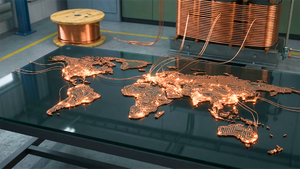
As of September 25, 2025, the financial markets are abuzz with anticipation surrounding silver, which appears to be on the verge of a monumental "historic breakout." Technical analysts are pointing to a rare and powerful 45-year "cup-and-handle" pattern on silver's long-term charts, a formation that, if confirmed, could unleash a new secular bull market for the precious metal. This multi-decade consolidation suggests a generational re-rating of silver, with profound implications for investors seeking to capitalize on what could be an explosive upward trajectory.
The potential for such a significant technical event is not merely an esoteric charting exercise; it represents a strong signal for investors, hinting at a fundamental shift in market dynamics. This long-term pattern, spanning nearly half a century, indicates a prolonged period of accumulation and a deep structural change in silver's supply-demand equilibrium. For precious metals investors, a decisive move above the critical resistance level—around the $50-$55 mark—could validate this pattern and usher in a period of substantial price appreciation, positioning silver as a key asset in diversified portfolios.
The 45-Year Countdown: Silver's Technical Masterpiece
The "cup-and-handle" pattern is a classic bullish continuation formation identified by technician William J. O'Neil, signaling a period of consolidation followed by a breakout. For silver, this pattern is of extraordinary duration and scale. The "cup" began forming around 1980 with silver's dramatic spike to nearly $50 per ounce, followed by a multi-decade decline to lows around $4 in the late 1990s and early 2000s, forming the rounded bottom. A subsequent powerful rally brought silver back to the $50 region in 2011, completing the right side of this massive cup.
Following the 2011 peak, silver entered a period of consolidation, forming the "handle" of the pattern. This handle has seen price action contained, gradually showing higher lows and persistent upward pressure, indicating a slow but steady accumulation by "strong hands." The critical "neckline" or resistance zone for this pattern lies squarely at the $50-$55 level, which silver has tested multiple times (1980, 2011) but has yet to decisively clear. A sustained weekly or monthly close above this threshold would be the ultimate confirmation of the breakout, signaling a potential move into uncharted territory.
The sheer length of this 45-year pattern makes it exceptionally significant. Long-term technical formations are generally considered more reliable and powerful than shorter-term ones, as they reflect deep-seated supply and demand dynamics, market psychology, and a lengthy accumulation phase. This generational base-building suggests that if the breakout materializes, the ensuing bull run could be both substantial and sustained, potentially leading to price targets well into the triple digits, according to some technical projections.
Fueling the Fire: Fundamental Tailwinds for Silver
While the technical picture is compelling, a sustainable breakout would require strong fundamental support, and silver appears to have a confluence of factors aligning in its favor. Foremost among these are inflation expectations. Like gold, silver is a traditional hedge against inflation, and with persistent inflationary pressures globally and central banks navigating complex monetary policies, investors are increasingly seeking tangible assets that can preserve purchasing power. Silver's dual nature as both a precious metal and an industrial commodity can make its response to inflation particularly dynamic.
Adding to its appeal is silver's enduring role as a safe-haven asset. In an era marked by geopolitical instability, economic uncertainties, and potential financial market volatility, silver offers a tangible measure of security. Investors tend to flock to precious metals during times of crisis, and silver's tangibility and limited supply contribute to its attractiveness as a store of value when other markets are turbulent.
Perhaps the most potent fundamental driver for silver is its increasing industrial demand, particularly from the burgeoning green technology sector. Silver's unparalleled electrical conductivity and thermal efficiency make it indispensable in numerous applications:
- Solar Panels: Photovoltaic (PV) cells are major consumers of silver, with global efforts towards renewable energy driving a surge in solar installations. Demand from this sector is projected to grow significantly, consuming an ever-larger portion of total silver supply.
- Electric Vehicles (EVs): EVs utilize significantly more silver (25-50 grams per vehicle) compared to traditional internal combustion engines, crucial for various electrical systems, battery technology, and safety features. The rapid adoption of EVs is set to triple automotive silver demand by 2040.
- Other Green Technologies: Wind turbines, energy storage systems, smart grid infrastructure, and fuel cells also rely on silver, further bolstering industrial demand.
These robust demand drivers are colliding with persistent supply constraints. Approximately 70-72% of global silver production is a byproduct of mining other metals (lead, zinc, copper, gold), meaning its supply cannot easily respond to its own price signals. Declining ore grades, underinvestment in exploration, rising operational costs, and geopolitical instability in major producing regions like Mexico and Peru further exacerbate the supply deficit. This structural imbalance, where demand consistently outstrips new supply, creates a powerful fundamental underpinning for sustained price appreciation, suggesting that upward pressure is inevitable as physical shortages manifest.
Winners and Losers in a Silver Surge
A significant increase in silver prices would create clear winners and losers across various industries.
Winners:
- Primary Silver Mining Companies: These companies stand to gain the most. Higher silver prices directly translate to increased revenue and expanded profit margins. Examples include Industrias Penoles SAB de CV (BMV: PE&OLES), Fresnillo PLC (LSE: FRES), Pan American Silver Corp. (TSX: PAAS, NASDAQ: PAAS), Hecla Mining Co. (NYSE: HL), Coeur Mining Inc. (NYSE: CDE), First Majestic Silver Corp. (NYSE: AG, TSX: FR), and Fortuna Silver Mines Inc. (NYSE: FSM, TSX: FVI). Their profitability is highly leveraged to silver prices, leading to potentially enhanced earnings and stock valuations.
- Diversified Precious Metals Miners with Significant Silver Output: Companies like Wheaton Precious Metals Corp. (TSX: WPM, NYSE: WPM) and Royal Gold Inc. (NASDAQ: RGLD) operate on streaming and royalty models, purchasing silver at fixed, lower prices. A rise in spot silver prices would significantly widen their margins, boosting profitability without direct mining operational costs. Even large diversified miners like BHP Group (ASX: BHP, NYSE: BHP) could see an unexpected boost from their silver byproduct output.
- Silver-Backed Exchange-Traded Funds (ETFs): These investment vehicles, such as the iShares Silver Trust (NYSEARCA: SLV), abrdn Physical Silver Shares ETF (NYSEARCA: SIVR), and Sprott Physical Silver Trust (NYSEARCA: PSLV), directly track the spot price of silver by holding physical bullion. Their asset value would increase proportionally with silver prices, offering investors direct exposure.
- Silver Miner ETFs: Funds like the Global X Silver Miners ETF (NYSEARCA: SIL) and iShares MSCI Global Silver and Metals Miners ETF (NYSEARCA: SLVP) invest in a basket of silver mining and royalty stocks, providing diversified exposure to the companies benefiting from higher prices.
Losers:
- Companies Heavily Reliant on Silver as an Industrial Input: Industries that use substantial amounts of silver in their manufacturing processes would face rising operational costs, potentially squeezing profit margins or necessitating higher consumer prices.
- Solar Panel Manufacturers: Companies like First Solar, Inc. (NASDAQ: FSLR) and other major players in China's burgeoning solar industry, including those under Reliance Industries Limited (NSE: RELIANCE) (through its solar manufacturing arm), would see increased input costs for solar cell production.
- Electronics Companies: Major manufacturers such as Apple (NASDAQ: AAPL), Samsung (KRX: 005930), NVIDIA (NASDAQ: NVDA), Dell (NYSE: DELL), and Sony (NYSE: SONY) utilize silver in integrated circuits, displays, PCBs, and connectors. Rising silver prices would increase material costs, potentially impacting profitability or leading to higher prices for consumer electronics.
- Automotive Companies (especially Electric Vehicles): Automakers, particularly those heavily invested in EV production, would face higher manufacturing costs. Leading EV manufacturers like Tesla (NASDAQ: TSLA), along with traditional automakers transitioning to EVs such as Volkswagen (XTRA: VOW3), BMW (XTRA: BMW), General Motors (NYSE: GM), and Ford (NYSE: F), would see increased input costs for silver used in electrical control units, sensors, and battery systems.
Broader Market Implications: A Generational Shift
A confirmed breakout in silver would signify more than just a price movement; it would represent a generational re-rating of the metal, reflecting a profound shift in market perception and valuation that has been brewing for decades. This event would fit into broader industry trends emphasizing tangible assets, inflation hedges, and the critical role of materials in the green energy transition.
The ripple effects would extend beyond the silver market. A strong silver bull run often signals robust demand for other precious metals, potentially pulling gold higher or indicating broader inflationary pressures. The gold-to-silver ratio, currently wide, suggests silver is historically undervalued relative to gold, implying a significant catch-up potential if the breakout occurs. This could attract capital flows from gold into silver, seeking higher beta exposure.
Regulatory or policy implications could also emerge. As silver's critical role in green technologies becomes more pronounced, governments might consider strategic stockpiling or policies aimed at securing supply chains, potentially classifying silver as a "critical mineral." This could further tighten supply and influence market dynamics.
Historically, multi-decade commodity breakouts have led to significant, sustained bull markets. For instance, gold's 27-year base breakout in 2007 preceded a 120% rally. The S&P 500 even formed a similar long-term cup and handle from 1937-1950, leading to one of the strongest bull markets in history. These precedents underscore the potential for explosive upside when such long-term technical patterns resolve, suggesting that silver could be at the cusp of its own historic ascent.
The Road Ahead: Navigating Silver's Potential Breakout
Should silver decisively break above the $50-$55 resistance zone, the short-term possibilities include rapid price appreciation, potentially reaching initial targets around $70-$100 per ounce. However, such a move would likely be accompanied by increased volatility and sharp, albeit temporary, corrections as the market digests the new price levels. For investors, this could present opportunities for strategic entry points or profit-taking.
In the long term, a confirmed 45-year breakout could launch silver into "blue sky territory" with no historical resistance overhead, paving the way for targets well into the triple digits, with some analysts even forecasting $130-$150 or higher over several years. This would necessitate strategic pivots or adaptations for investors, potentially involving increasing exposure to silver through physical holdings, ETFs, or silver mining stocks, and considering options strategies to leverage potential upside while managing risk.
Market opportunities would emerge for both traditional precious metals investors and those focused on the green energy transition. Silver's dual nature makes it attractive to both camps. The challenges would include managing increased price volatility and discerning genuine breakouts from false signals. Furthermore, the supply-demand dynamics would remain crucial, with any significant shift in industrial demand or mining output potentially influencing the trajectory.
Potential scenarios range from a rapid, sustained ascent driven by institutional inflows and heightened retail interest to a more gradual, stair-stepping climb characterized by periodic consolidations. The most bullish outcome would see silver reassert its historical monetary role while simultaneously benefiting from its industrial indispensability in the modern economy.
Conclusion: A New Era for the White Metal?
In summary, silver stands at a pivotal juncture, with a compelling 45-year cup-and-handle technical pattern signaling the potential for a historic breakout. This technical setup is powerfully reinforced by strong fundamental tailwinds, including persistent inflation expectations, its role as a safe-haven asset, booming industrial demand from green technologies, and structural supply constraints. The confluence of these factors creates an exceptionally bullish environment for the white metal.
Moving forward, investors should closely monitor the $50-$55 resistance level. A sustained breach of this long-standing barrier would be the ultimate confirmation of a new secular bull market. Key economic data, particularly inflation reports, central bank monetary policy decisions, and updates on industrial demand (especially from the solar and EV sectors), will be crucial watch points in the coming months. If the breakout materializes, silver could offer significant upside potential, reshaping portfolios and cementing its status as a vital asset in the evolving global economy. The question is not if silver will break out, but when, and how high it will ultimately climb in this potential new era.
This content is intended for informational purposes only and is not financial advice.





